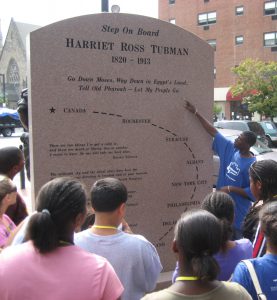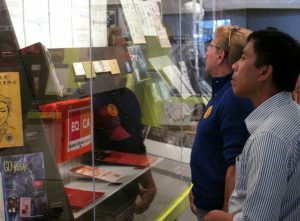Momentum came across this great article about nonprofit stories and the different forms they come in. Read the article below:
Many nonprofit stories take the form of online videos, but there are plenty of other forms. Consider the following examples for inspiration.
Oral history: The ACT UP Oral History Project documents the history of the AIDS activist group. TheVanguard Revisited project enlisted homeless LGBTQ youth in San Francisco to document the history of their predecessors and take their own place in history. Voice of Witness produces books of oral histories on contemporary human-rights crises. Slave narratives recorded by the Federal Writers’ Project provided a training ground for socially conscious writers such as Zora Neale Hurston, Studs Terkel, and Richard Wright.Groundswell is a network of people using oral history and narrative for movement-building and social change.
Posters, plaques, stickers: The Neighborhood Story Project in New Orleans did a series of open lettersfrom workers at the local racetrack, and a poster series about them as well. Some groups place historical markers, such as the series of LGBT history plaquesin Chicago or artist Norm Magnusson’s political messages on official-looking signs along Interstate 75. College activists have also used stickers that tell personal stories to reduce abortion stigma.
Mobile story-mapping: I-Witness Central City, a project of Mondo Bizarro in New Orleans, and theBerkeley Historical Plaque Project place markers at historic sites from which passersby can dial a phone number to listen to a story about that site.
Story booths: In an initiative called Generations HIV, the HIV Story Project set up a story-gathering booth at sites around the Bay Area. (Watch a short video about the project.)
Walking tours and historical-site tours: During its 15 years of operation, MYTOWN trained nearly 400 Boston youth to create and lead historical walking tours. Though plantation tours arenotoriously light on information about slaves, some do focus on slavery, such as the Whitney Plantation in Louisiana.
Comic books: A Kenyan group called Well Told Storyproduces comic books, radio dramas, and other media on issues such as HIV and agricultural practices. The United Nations is usingcomic books to build support for international development. In 1958, the Fellowship of Reconciliation published a 16-page comic book calledMartin Luther King and the Montgomery Story; an Arabic translation was used by Egyptian activists before the Arab Spring as a point of departure for discussion about nonviolent social change.
Online museums: America’s Black Holocaust Museum is a series of online exhibits about the history of lynching in the U.S. Girl Museum presents online exhibitions, publications, and videos to advocate for girls as forces for change, “not as victims and consumers.”
Brick-and-mortar museums: The GLBT History Museum in San Francisco tells stories on themes such as the struggle for self-determination.
In the basement of the First Congregational Church of Detroit, the Underground Railroad Living Museumhas “conductors” lead visitors through elaborate sets from plantation to swamp to safe house to the Ohio River and freedom. The International Coalition of Sites of Conscience is a global network of historic sites, museums, and initiatives that help the public “envision and shape a more just and humane future.”
Traveling museums: The Florida Modern-Day Slavery Museum is a cargo truck that contains displays on the history of slavery in Florida, up to as recent a case as 2008, with the abuse of farmworkers in the state; it has toured the Southeast and beyond.
Puppetry: One of the best-known groups to use puppetry for social change isBread and Puppet Theater. Other groups include Spiral Q in Philadelphia, Wise Fool New Mexico, and Puppet Underground in Washington, D.C. “A Brief History of Puppets and Social Justice” is a good primer.Sanitation and Health Rights in India works to end open defecation in that country; the first in a series of five videos about the group details a collaboration with a puppet theater company.
Theater and shared scripts: El Teatro Campesino was founded in 1965 amid the grape strike of the United Farm Workers and performed short skits in union halls and on flatbed trucks to rally support for the cause. Some organizations make scripts available for community groups to put on their own performances, such as 8, a play about the debate over marriage equality based on the federal trial of California’s Prop. 8. Cornerstone Theater Company in Los Angeles produces site-specific plays on themes such as hunger and the plight of day laborers.
Games: Cops & Rubbers is a table-top game by designer Lien Tran and funded by the Open Society Foundations that puts players in the shoes of sex workers in cities and countries worldwide where a condom is enough evidence of sex work to get you arrested or extorted. Games for Change promotes games based on real-life social problems. The social-network game EVOKE was a “10-week crash course in changing the world,” in which players in classrooms around the world generated ideas to real-world problems.
Transmedia: Projects such as the Sandy Storyline tell personal stories through a combination of text, audio, photo, and video, humanizing overwhelming or seemingly abstract events. A sister project isHousing Is a Human Right, a creative storytelling project on housing and home.
Speaking tours, open mikes, and other live forms: The Moth’s open-mike “story slams” take place in more than a dozen U.S. cities and internationally, and they also provide community and education programs for high school students and marginalized adults in New York City. Exhale sponsored a “Pro-Voice” speaking tour of college campuses for women to share their personal abortion experiences.
Music: What stories are more memorable than those told in song? Contemporary musicians with story-songs include Jasiri X and Toshi Reagon. Classic songs that tell stories include Bob Dylan’s “The Death of Emmett Till” and “Hurricane” and Sweet Honey in the Rock’s“Ballad of the Broken Word.”
Twitter and Facebook: It’s hard but not impossible to tell a story in a single Facebook post or 140-character tweet. Novelist Teju Colewrote “seven very short stories about drones” on Twitter. Another Twitter story unfolded over the course of 33 re-tweets and was called “Hafiz” (explained more onWired).
Online publishing: Wattpad and Storify are web platforms for creating, reading, and sharing stories, from social-media collages to fan fiction to novels to serial stories. (Read this Hatch blog post on how to make the best use of Storify.)
Reenactments: In his Slave Rebellion Reenactment, artist Dread Scott will reinterpret an 1811 uprising in the place where it happened. For her “Soldiers Stories” project, photographer Jennifer Karady had American veterans of the wars in Iraq and Afghanistan re-create combat situations they experienced in war.
Journalism: Renaissance Journalism reimagines the media as a “vital source of education, engagement, and empowerment for underserved communities.” Images and Voices of Hope promotes “media as agents of world benefit,” and the Solutions Journalism Network encourages journalists to cover responses to social problems. The Global Press Institute trains women in developing countries as journalists, publishes their stories in the organization’s own Global Press Journal, and syndicates them via their Global Press News Service; read a story about the group in the Chronicle of Philanthropy.
Documentary and fiction film: Years’ worth of documentary film exists on virtually every social cause. Groups like Active Voice Lab, Working Films and the Stories of Change partnership work with media-makers, funders, community groups, and others to link those films to social-change movements.
Radio: Youth Radio trains young people from diverse backgrounds in digital media and technology and distributes their stories through major media outlets. And outLoud Radio gives “LGBTQ and ally youth the skills and confidence to represent themselves.”
Source: Working Narratives

